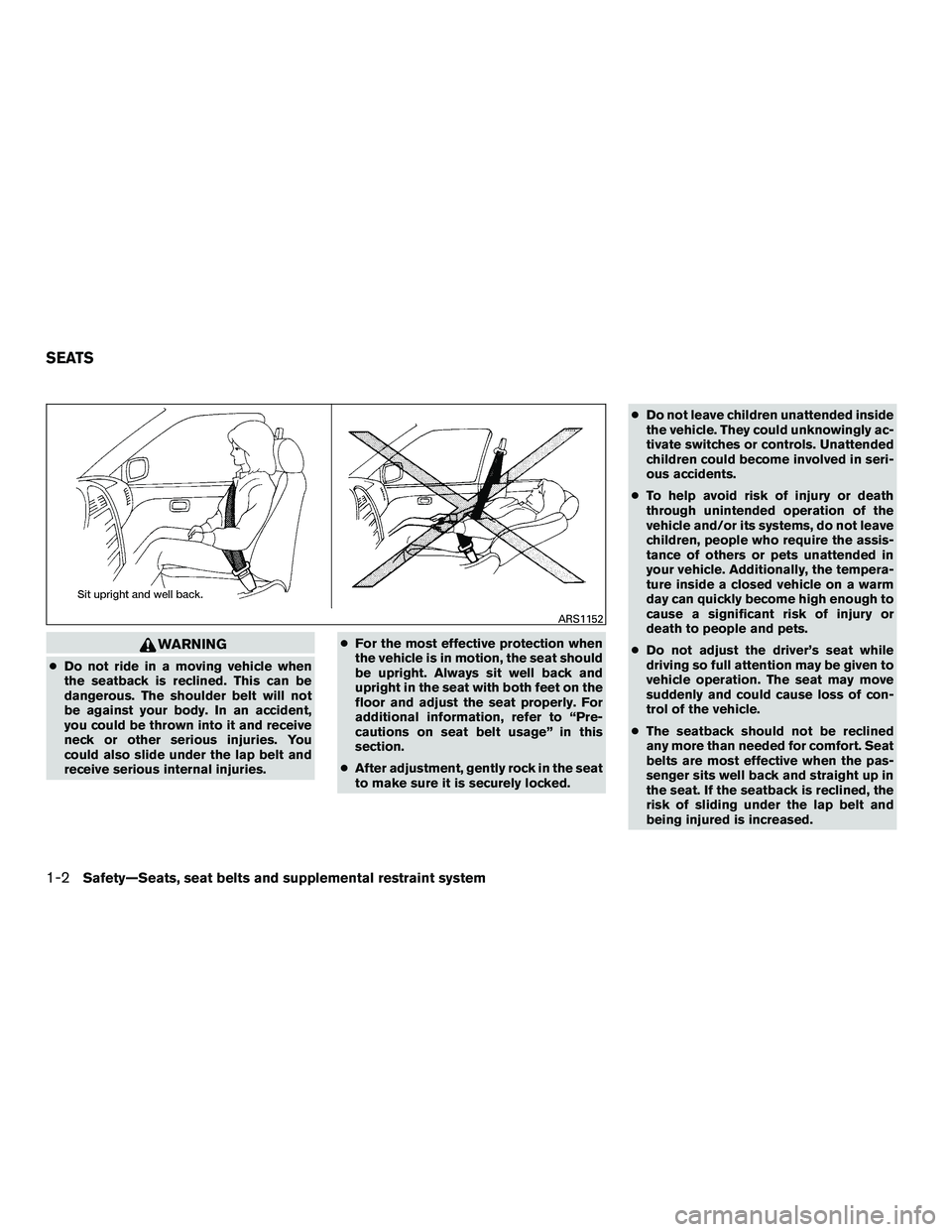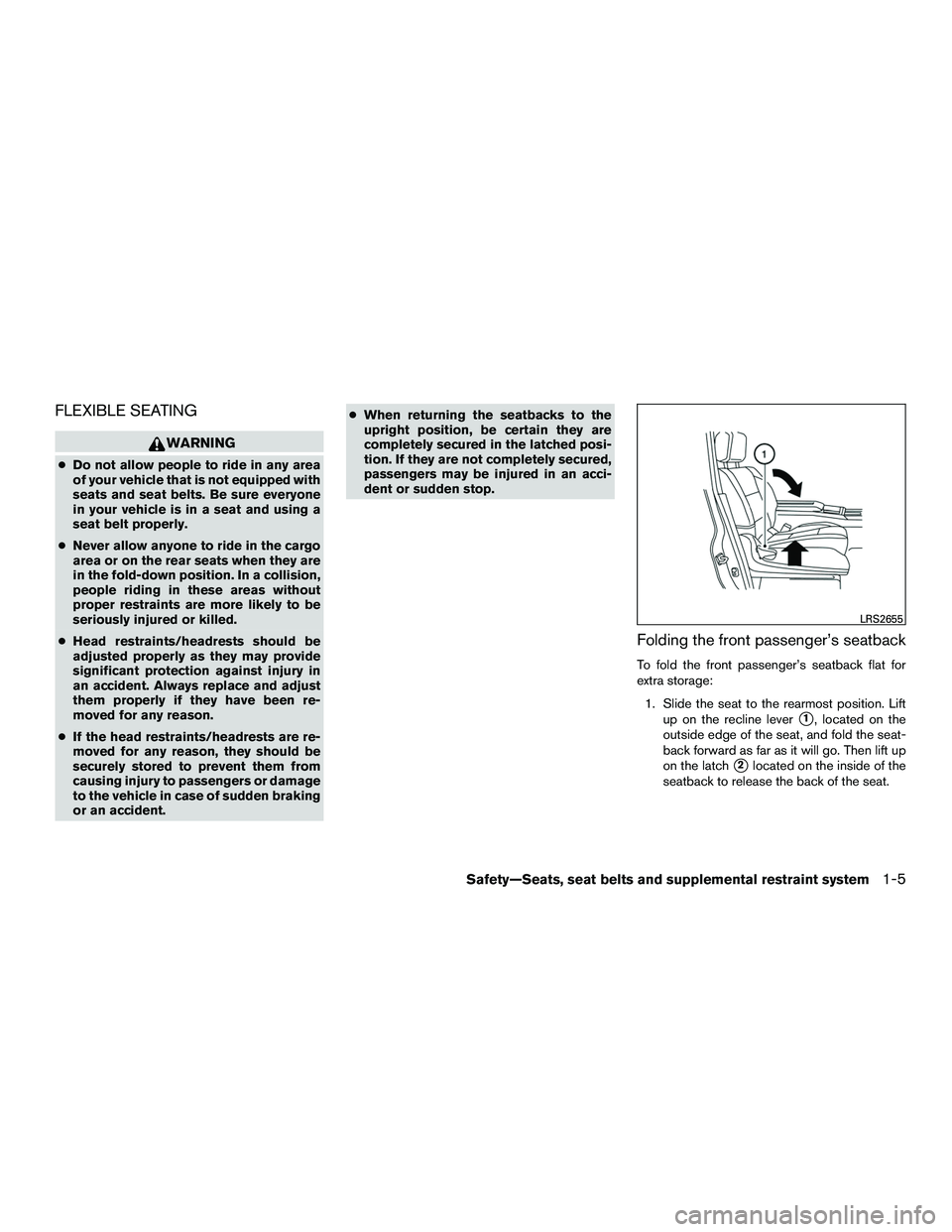Page 8 of 312
Table of Contents
Illustrated table of contents
Safety—Seats, seat belts and supplemental restraint system
Instruments and controls
Pre-driving checks and adjustments
Monitor, climate, audio, phone and voice recognition systems
Starting and driving
In case of emergency
Appearance and care
Maintenance and do-it-yourself
Technical and consumer information
Index
0
1
2
3
4
5
6
7
8
9
10
Page 11 of 312
1. Front seat belt with pretensioner andshoulder height adjuster (P. 1-11, 1-40)
2. Roof-mounted curtain side-impact and
rollover supplemental air bag (P. 1-40)
3. Head restraints/headrests (P. 1-7)
4. Supplemental front-impact air bags
(P. 1-40)
5. Seats (P. 1-2)
6. Occupant classification sensor
(weight sensor) (P. 1-40)
7. Front seat-mounted side-impact supple-
mental air bag (P. 1-40)
8. Front seat-mounted side-impact supple-
mental air bag modules (P. 1-40)
9. LATCH (Lower Anchors and Tethers for
CHildren) (P. 1-20)
10. Rear seat top tether strap anchor
(located on bottom of seatback)
(P. 1-20)
Refer to the page number indicated in
parentheses for operating details.
LII2354
AIR BAGS, SEAT BELTS AND CHILD
RESTRAINTS
0-2Illustrated table of contents
Page 14 of 312
1. Map light (P. 2-29)
2. Sun visors (P. 3-17)
3. Rearview mirror (P. 3-17)
4. Glove box (P. 2-23)
5. Cup holders (P. 2-23)
6. Front seats (P. 1-2)
7. Rear seats (P. 1-2)
8. Vehicle loading (P. 9-12)
Refer to the page number indicated in
parentheses for operating details.
LII2441
PASSENGER COMPARTMENT
Illustrated table of contents0-5
Page 20 of 312

1 Safety—Seats, seat belts and
supplemental restraint system
Seats............................................1-2
Front manual seat adjustment . . ..................1-3
Armrest (driver’s side only) ......................1-4
Flexible seating .................................1-5
Head restraints/headrests ..........................1-7
Adjustable head restraint/headrest
components ...................................1-8
Non-adjustable head restraint/headrest
components ...................................1-8
Remove .......................................1-9
Install .........................................1-9
Adjust ........................................ 1-10
Seat belts ....................................... 1-11
Precautions on seat belt usage ..................1-11
Seat belt warning light ......................... 1-14
Pregnant women .............................. 1-14
Injured persons ................................ 1-14
Three-point type seat belt with retractor ..........1-14
Seat belt extenders ............................ 1-17
Seat belt maintenance ......................... 1-17Child safety
...................................... 1-18
Infants ........................................ 1-19
Small children ................................. 1-19
Larger children ................................ 1-19
Child restraints ................................... 1-20
Precautions on child restraints ..................1-20
LATCH (Lower Anchors and Tethers for
CHildren) System ............................. 1-22
Rear-facing child restraint installation using
LATCH....................................... 1-24
Rear-facing child restraint installation using
the seat belts ................................. 1-26
Forward-facing child restraint installation
using LATCH .................................. 1-29
Forward-facing child restraint installation
using the seat belts ............................ 1-33
Booster seats ................................. 1-37
Supplemental Restraint System (SRS) ..............1-40
Precautions on SRS ........................... 1-40
Supplemental air bag warning labels .............1-57
Supplemental air bag warning light ..............1-58
Page 21 of 312

WARNING
●Do not ride in a moving vehicle when
the seatback is reclined. This can be
dangerous. The shoulder belt will not
be against your body. In an accident,
you could be thrown into it and receive
neck or other serious injuries. You
could also slide under the lap belt and
receive serious internal injuries. ●
For the most effective protection when
the vehicle is in motion, the seat should
be upright. Always sit well back and
upright in the seat with both feet on the
floor and adjust the seat properly. For
additional information, refer to “Pre-
cautions on seat belt usage” in this
section.
● After adjustment, gently rock in the seat
to make sure it is securely locked. ●
Do not leave children unattended inside
the vehicle. They could unknowingly ac-
tivate switches or controls. Unattended
children could become involved in seri-
ous accidents.
● To help avoid risk of injury or death
through unintended operation of the
vehicle and/or its systems, do not leave
children, people who require the assis-
tance of others or pets unattended in
your vehicle. Additionally, the tempera-
ture inside a closed vehicle on a warm
day can quickly become high enough to
cause a significant risk of injury or
death to people and pets.
● Do not adjust the driver’s seat while
driving so full attention may be given to
vehicle operation. The seat may move
suddenly and could cause loss of con-
trol of the vehicle.
● The seatback should not be reclined
any more than needed for comfort. Seat
belts are most effective when the pas-
senger sits well back and straight up in
the seat. If the seatback is reclined, the
risk of sliding under the lap belt and
being injured is increased.
ARS1152
SEATS
1-2Safety—Seats, seat belts and supplemental restraint system
Page 22 of 312

CAUTION
When adjusting the seat positions, be
sure not to contact any moving parts to
avoid possible injuries and/or damage.
FRONT MANUAL SEAT
ADJUSTMENT
Your vehicle seats can be adjusted manually. For
additional information about adjusting the seats,
refer to the steps outlined in this section.
Forward and backward
Pull the center of the bar up and hold it while you
slide the seat forward or backward to the desired
position. Release the bar to lock the seat in
position.
Reclining
To recline the seatback, pull the lever up and lean
back. To bring the seatback forward, pull the lever
up and lean your body forward. Release the lever
to lock the seatback in position.
The reclining feature allows adjustment of the
seatback for occupants of different sizes for
added comfort and to help obtain proper seat
belt fit. For additional information, refer to “Pre-
cautions on seat belt usage” in this section. Also,
the seatback can be reclined to allow occupants
to rest when the vehicle is stopped and the shift
lever is in the P (Park) position.
LRS2651LRS2653
Safety—Seats, seat belts and supplemental restraint system1-3
Page 23 of 312
Seat lifter (driver’s seat)
Pull up or push down the adjusting lever to adjust
the seat height until the desired position is
achieved.
Lumbar support (driver’s seat)
The lumbar support feature provides adjustable
lower back support to the driver. Move the lever
forward or backward to adjust the seat lumbar
area.
ARMREST (driver’s side only)
To use the armrest, pull it down to the resting
position.
�AStowed position
�BResting position
LRS2652LRS2654LRS2339
1-4Safety—Seats, seat belts and supplemental restraint system
Page 24 of 312

FLEXIBLE SEATING
WARNING
●Do not allow people to ride in any area
of your vehicle that is not equipped with
seats and seat belts. Be sure everyone
in your vehicle is in a seat and using a
seat belt properly.
● Never allow anyone to ride in the cargo
area or on the rear seats when they are
in the fold-down position. In a collision,
people riding in these areas without
proper restraints are more likely to be
seriously injured or killed.
● Head restraints/headrests should be
adjusted properly as they may provide
significant protection against injury in
an accident. Always replace and adjust
them properly if they have been re-
moved for any reason.
● If the head restraints/headrests are re-
moved for any reason, they should be
securely stored to prevent them from
causing injury to passengers or damage
to the vehicle in case of sudden braking
or an accident. ●
When returning the seatbacks to the
upright position, be certain they are
completely secured in the latched posi-
tion. If they are not completely secured,
passengers may be injured in an acci-
dent or sudden stop.
Folding the front passenger’s seatback
To fold the front passenger’s seatback flat for
extra storage:
1. Slide the seat to the rearmost position. Lift up on the recline lever
�1, located on the
outside edge of the seat, and fold the seat-
back forward as far as it will go. Then lift up
on the latch
�2located on the inside of the
seatback to release the back of the seat.
LRS2655
Safety—Seats, seat belts and supplemental restraint system1-5